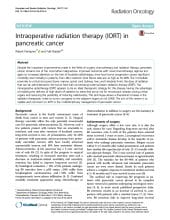Authors
Robert Krempien and Falk Roeder
Abstract
Despite the important improvements made in the fields of surgery, chemotherapy and radiation therapy, pancreatic cancer remains one of the most lethal malignancies. Improved outcomes with novel chemotherapy regimes led again to increased attention on the role of localized radiotherapy, since local tumor progression causes significant morbidity and mortality in patients. Even after resection local failure rates are as high as 50–80%. The immediate proximity to critical structures (bone marrow, spinal cord, kidneys, liver, and intestine) limits the dose of radiation that can be administered to the tumor bed with conventional external beam radiation therapy (EBRT). The intraoperative radiotherapy (IORT) appears to be an ideal therapeutic strategy for this disease, having the advantage of enabling the delivery of high doses of radiation to areas that are at risk for microscopic disease, saving critical organs and reducing the possibility of inducing radiotoxicity. This technique allows a theoretical increase in the radiation therapeutic index to tumor compared to the adjacent organs at risk (OAR). The aim of this review is to update and comment on IORT in the multidisciplinary management of pancreatic cancer.
